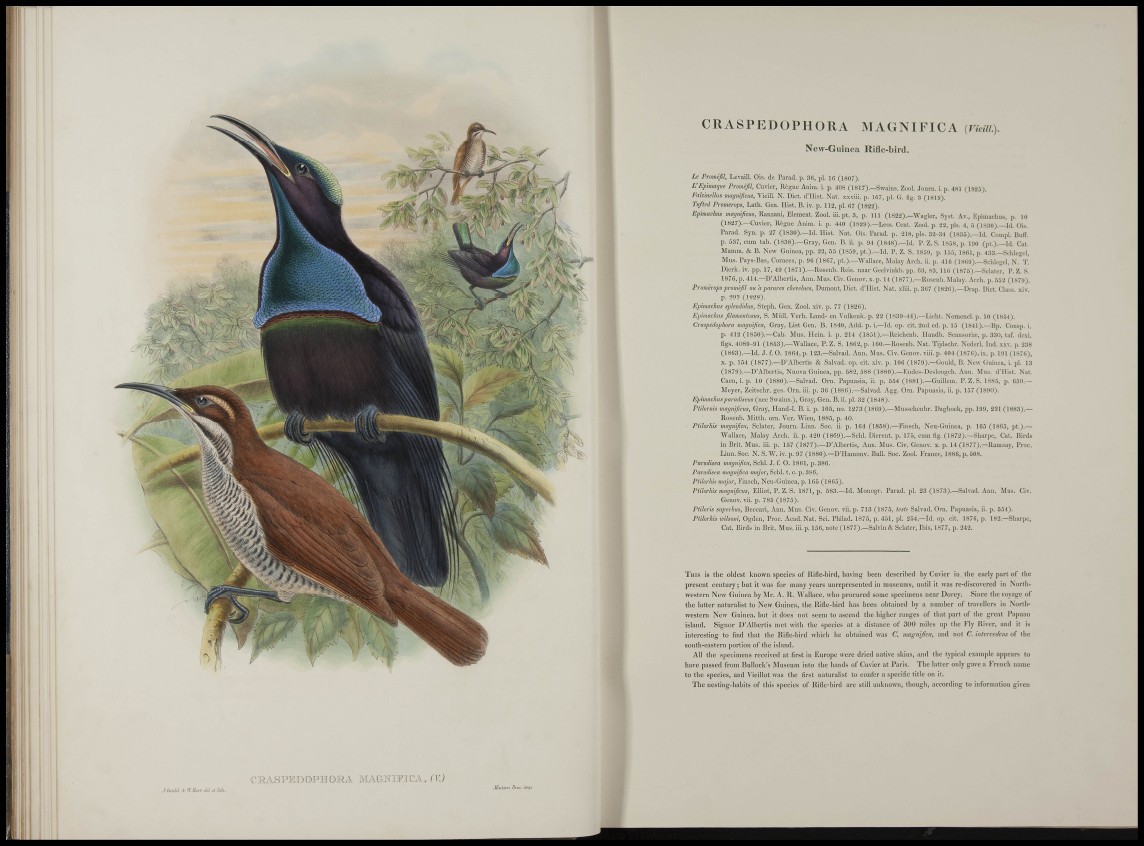
i
ì
i:.
•f! i-
[11 li
lili
i i!/
CS^AYSPEDOPHORA aiAiGri^IlFICA, (V.)
j.r^'iU A ir.Äi// tiri."/ liüi. MiiUm ßivf. imf)
C R A S P E D O P H O R A MAGNIFICA (ne///.).
New-Guinea Rifle-bird.
Le Proméfil, Levaill. Oìs. de Parad. p. 36, pi. 16 (1807).
L'Epimaque Promifil, Cuvier, Règne Anim. i. p. 408 (1817).—Swains, Zool. Joum. i. p. 481 (1825).
Falcimllus magnificm, Vieill. N. Diet. d'Hist. Nat. xxviii. p. 167, pi. G. fig. 3 (1819).
Tufted Promerops, Lath. Gen. Hist. B. iv. p. 112, pi. 07 (1822).
Eplmichus magnificm, Rauzani, Element. Zool. iii.pt. 3, p. I l l (1822).—Wagler, Syst. Av., Epimachus, p. lu
(1827).—Cuvier, Règne Anim. i. p. 440 (1829).—Less. Cent. Zoul. p. 22, pis. 4, 5 0830) .—Id. Ois.
Parad. Syn. p. 27 (1830).—Id. Hist. Nat. Ois. Parad. p. 218, pis. 32-3-4 (1835).—Id. Compi. Ituff.
p. 537, cum tab. (1838).—Gray, Gen. B. ii. p. 94 (1848).—Id. P. Z. S. 1858, p. 190 (pt.).—Id. Cat.
Mamm. & B. New Guinea, pp. 22, 55 (1859, pt.).—Id, P. Z. S. 1859, p. 155, 1861, p. 433.—Schlegel,
Mus. Pays-Bas, Coraces, p. 96 (1867, pt.).—Wallace, Malay Areh. ii. p. 416 (1869).—Schlegel, N. T.
Dierk. iy. pp. 17, 49 (1871).—Roscnb. Reis, naar Geelvinkb. pp. 03, 83, 116 (1876).—Selater, P. Z. S.
1870, p, 414.—D'Albertis, Ann. Mus. Civ. Genov. x. p. 14 (1877).—Rosenb. Malay. Arch, p, 552 (1879).
Promerops promifil ou a parwes cliemhes, Dumont, Diet. d'Hist. Nat. xhii. p. 367 (1826).—Drap. Diet. Class, xiv.
p. 293 (1828).
Epimachus splendidtis, Steph. Gen. Zool. xiv. p. 77 (1826).
Epimachus filamentosus, S. Müll. Verb. Land- en Volkenk, p. 22 (1839-44).—Lieht. Nomencl. p. 10 (1854).
Craspedophora magnifica. Gray, List Gen. B. 1840, Add. p. i.—Id. op. eit. 2nd ed. p. 15 (1841),—Bp. Consp, i,
p. 413 (1850).—Cab. Mus. Hein. i. p. 214 (1851).—Reichenb. Handb. SeansoriiE, p, 330, taf. dcxi.
figs. 4089-91 (1853).—Wallace, P.Z, S. 1862, p, 160.—Rosenb. Nat. Tijdschr. Nederl. Ind.xxv. p. 238
(1863).—Id. J. f. O. 1804, p. 123,—Salvad. Ann, Mus. Civ. Genov. viii. p. 404 (1870), ix. p. 191 (1870),
X. p. 154 (1877).—D'Albertis & Salvad. op. cit. xiv. p. 106 (1879).—Gould, B. New Guinea, i. pi. 13
(1879).—D'Albertis, Nuova Guinea, pp. 582, 588 (1880).—Endes-Dcslongch. Ann. Mus. d'Hist. Nat.
Caen, i. p. 10 (1880).—Salvad. Orn. Papuasia, ii. p. 554 (1881).—Guillcm. P. Z, S, 1885, p. 650.—
Meyer, Zeitscbr. ges. Orn. iii, p, 36 (1886).—Salvad. Agg. Orn. Pa])uasia, ii. p. 157 (1890).
Epimachusparadiseiis (nee Swains.), Gray, Gen, B. ii. pi. 32 (1848).
Ptilornis magnificus. Gray, Hand-1, B. i, p, 105, no. 1273 (1869).—Musschenbr. Dagboek, pp. 199, 231 (1883).—
Rosenb. Mitth, orn. Ver. Wien, 1885, p, 40.
Plihrhis magnifica, Selater, Journ. Linn. Soc. ii. p, 164 (1858).—Pinsch, Neu-Guinca, p. 165 (1805, pt.).—
Wallace, Malay Arch. ii. p. 420 (1809).—Sehl. Dierent. p. 175, cum fig. (1872).—Sharpe, Cat. Birds
in Brit. Mus. iii. p. 157 (1877),—D'Albertis, Ann. Mus. Civ. Genov. x. p. 14 (1877),—Ramsay, Proc.
Linn. Soc. N, S. W , iv, p. 97 (1880).—D'llamonv. Bull. Soc. Zool. France, 1886, p. 508.
Paradisea magnifica, Sehl. J. f. O. 1861, p. 386.
Paradisea magnifica major, Schi. t. c. p. 386.
Ptilorhis major, Finsch, Neu-Guinea, p. 105 (1805).
Plihrhis magnificus, Elliot, P, Z. S. 1871, p. 583.—Id. Monogr. Parad. pi. 23 (1873).—Salvad. Ann. Mus. Civ.
Genov. vii. p. 785 (1875).
Pliloris superhus, Beecari, Ann. Mus. Civ. Genov. vii, p. 713 (1875, leste Salvad. Orn. Papuasia, ii. p, 554).
Plihrhis wilsoni, Ogden, Proc, Acad, Nat, Sci. Philad. 1875, p. 451, pi. 254.—Id. op. cit. 1876, p. 182.—Sharpe,
Cat. Birds in Brit. Mns. iii. p. 156, note (1877).—Salvin & Selater, Ibis, 1877, p. 242.
THIS is the oldest known species of Rifle-bird, having been descrilied by Cuvier in the early part of the
j)resent century; but it was for many years unrepresented in museums, until it was re-di.scovcred in Northwestern
New Guinea by Mr . A. R. Wallace, who ])rocured some specimens near Dorey, Since the voyage of
the latter naturalist to New Guinea, the Kifle-hrrd has been obtained by a number of travellers in Northwestern
New Guinea, but it does not seem to ascend tlie higher ranges of tliat part of the great Papuan
island. Signor D'Albertis met with the species at a distance of 300 miles uj) the Fly River, and it is
interesting to find that the Rifle-bird which he obtained was C. magtiijica, and not C. iniercedens of the
south-eastern portion of the island.
All the specimens received at first in Europe were dried native skins, and the typical example appears to
have passed from Bullock's Museum into the hands of Cuvier at Paris, The latter only gave a French name
to the species, and Vieillot was the first naturalist to confer a specific title on it.
The nesting-habits of this species of Rifle-bird are still unknown, though, according to information given